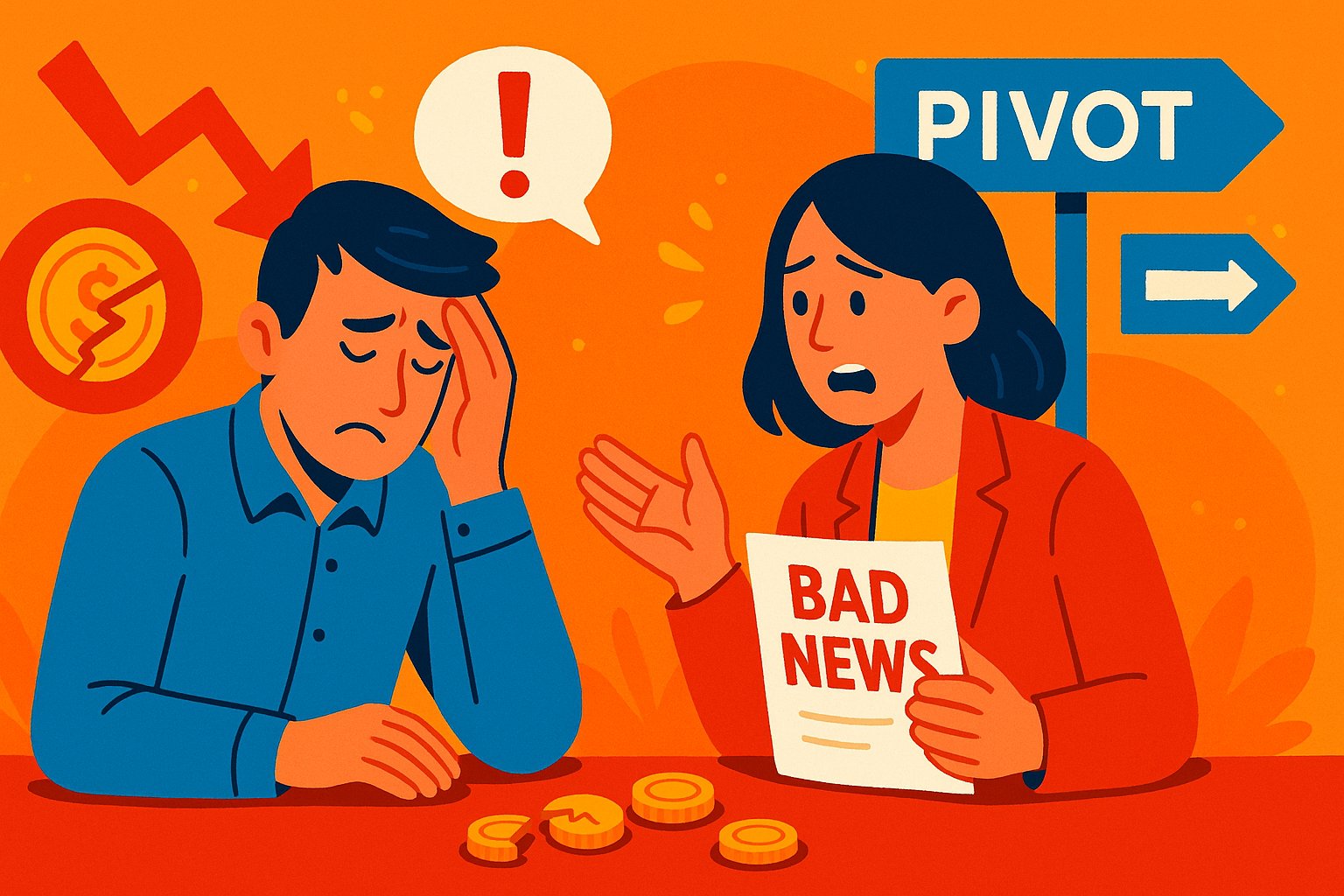Confronting the Unthinkable: The Imperative of Honest Communication
Delivering bad news to equity investors ranks among the most daunting tasks founders face. After months or years of tireless effort, setbacks—be they product delays, cash-flow gaps, or regulatory roadblocks—can feel like personal failures. Yet, embracing transparency during turbulent times is not only ethical; it’s fundamental to preserving trust, maintaining credibility, and rallying your community toward solutions. This opening exploration unpacks why forthright communication during adversity can transform potential investor disillusionment into renewed allegiance—and previews the strategic steps you’ll learn to navigate these challenging conversations with clarity, compassion, and confidence.
When your crowdfunding backers entrust you with their hard-earned capital, they tacitly accept risk—but they also expect candid engagement when things go awry. Avoiding or sugarcoating bad news only amplifies investor anxiety, erodes goodwill, and risks reputational damage that hinders future fundraising. Conversely, founders who tackle setbacks head-on—framing them within a structured narrative of causes, impacts, and corrective plans—strengthen the partnership ethos that underpins successful equity crowdfunding. In the sections that follow, we’ll explore the art of crafting regretful yet purposeful announcements, choosing the right communication channels, delivering messages with empathy, and mobilizing investor support to surmount obstacles together.
Illuminating the Why: Framing the Setback Narrative
Before you hit “send” on your investor memo, pause to distill the essence of the challenge. Investors need context to process disappointment productively. Begin by explaining the root causes: was a strategic partner unable to meet quality standards? Did a sudden regulatory clarification reshape your market entry timeline? Clearly delineate internal versus external factors, illustrating that you’ve conducted a thorough post-mortem rather than offering reactive excuses.
Next, detail the impact assessment—how does the setback affect timelines, budgets, or product scope? For example, a manufacturing glitch might shift your beta launch by six weeks and increase costs by 8 percent. By quantifying the effects, you give investors a factual basis for their concerns while demonstrating analytic rigor. Finally, acknowledge the emotional dimension: express genuine regret that the road map has veered off course, reinforcing that you value their trust and are committed to restoring momentum. Framing bad news within this structured narrative lays the groundwork for constructive dialogue and investor confidence.
Choosing the Right Forum: Channels for Delivering Difficult Updates
The medium you choose for bad news matters as much as the message itself. For high-stakes developments—such as missing a critical milestone or recruiting freeze—opt for live video briefings or webinars. A real-time forum enables you to convey sincerity through tone and body language, respond to investor questions immediately, and gauge sentiment as you speak. Ensure you provide a clear agenda and allow ample Q&A time, signaling that you value dialogue over monologue.
For less urgent but still significant setbacks—like minor schedule shifts or budget overruns—an email memo with a scheduled follow-up call can suffice. Structure the email with a concise summary at the top, then expand into details and corrective steps, before inviting investors to a one-on-one conversation if they wish. Avoid impersonal public blog posts or social-media blasts for bad news; they risk signaling detachment and can amplify frustration. By selecting the forum that matches the gravity of the situation, you demonstrate respect for your investors’ need for engagement and clarity.
Timing with Care: When to Break the Bad News
Delivering bad news at the right moment can mitigate its impact. Resist the impulse to delay disheartening updates until an “ideal” time, as withholding information usually provokes rumors and speculation. Instead, adopt a proactive disclosure approach: notify investors within 24 to 48 hours of the setback’s confirmation. This window balances your need to gather accurate information with investors’ need for timeliness.
Avoid Friday late afternoons or pre-holiday weekends, when your announcement may be lost amid personal plans and leave investors feeling stranded without immediate recourse. If possible, choose mid-week mornings—when recipients are attentive—to share news and schedule follow-up interactions. When timing aligns with investor availability, you maximize the chances for a calm reception and constructive engagement, reinforcing your commitment to transparency.
Conveying Empathy: The Human Touch Amid Hardship
While precision matters, tone is equally critical. A purely clinical recitation of problems can feel cold and disconcerting. Begin your communication with a heartfelt acknowledgement: express regret for the setback’s impact on investors’ trust and plans. Recognize the emotional investment behind every share purchase, and affirm your shared commitment to the venture’s mission.
Use inclusive language—“we’re facing this challenge together”—to underscore the partnership ethos. Pause to recognize team efforts and investor patience, humanizing the narrative. This empathetic framing helps assuage fears by reminding backers that they’re not mere capital providers but collaborative stakeholders whose support motivates problem-solving. When you convey empathy authentically, you soften the blow and facilitate a more constructive investor mindset.
Mapping the Recovery Path: Presenting a Concrete Action Plan
Investors crave solutions as much as they deserve honesty about problems. After clearly defining the issue, pivot to the corrective action plan. Lay out specific steps, responsibilities, and timelines: engage a new supplier within two weeks, allocate X percent of contingency funds to expedite retooling, and schedule a progress check-in at the end of the next sprint.
Anchoring your plan in granular details conveys that you’ve moved beyond diagnosis to decisive leadership. Include resource implications—budget, headcount, or advisory support—so investors understand how you’ll marshal assets to overcome the obstacle. By mapping a credible recovery path, you convert frustration into forward momentum and reassure backers that their investment remains in capable hands.
Encouraging Investor Involvement: Channeling Support Constructively
Equity crowdfunding investors often bring networks and expertise that can help you navigate roadblocks. Conclude your update by inviting collaborative support: ask experienced backers for vendor referrals, solicit advice from those with operational backgrounds, or propose an informal advisory roundtable to vet your recovery strategy. This call to action has dual benefits: it harnesses investor goodwill to expedite solutions and deepens stakeholder engagement through active participation.
Moderate these invitations carefully—avoid overwhelming your investors or conflating payments with gratis consulting. Frame assistance opportunities as voluntary contributions that add value to the community, rather than obligations. When backers coalesce around problem-solving, they cement their emotional and intellectual commitment, transforming adversity into a galvanizing force for collective success.
Maintaining Momentum: The Follow-Up Cadence
Delivering bad news is only the start; the follow-up cadence cements your credibility. Schedule regular progress updates—perhaps weekly during the crisis phase—reporting on action-plan milestones, unexpected developments, and revised timelines. Even when progress is incremental, communicate small wins—completed prototype tests or legal amendments secured—to sustain optimism.
Balance these crisis updates with your established broader-journey communications so investors see both short-term responsiveness and long-term strategic continuity. Consistency in follow-up underscores that you haven’t abandoned your transparency principles when times are tough, reinforcing the trust that will carry you—and your community—through rough patches.
Learning and Adapting: Turning Setbacks into Strategic Insights
Every unanticipated hurdle offers a learning opportunity. Once the immediate crisis abates, organize a reflective session—shared with willing investors if appropriate—to review root causes, process gaps, and systemic improvements. Summarize these insights in your next major update, outlining policy changes, new risk-management protocols, or process automations you’re adopting to prevent recurrence.
Demonstrating that you’ve institutionalized lessons learned showcases your commitment to continuous improvement. It reassures investors that setbacks catalyze growth rather than derail momentum. This adaptive mindset positions your venture as resilient and self-aware—qualities that deeply resonate with discerning backers seeking robust, future-ready leadership.
Guarding Your Reputation: The Long-Term Reputation Dividend
How you handle bad news profoundly shapes your reputation in the crowdfunding ecosystem. Founders who navigate adversity with transparency, empathy, and strategic acumen earn respect from current investors and peer founders alike. Word spreads fast in tight-knit equity crowdfunding networks: positive testimonials about your communicative integrity can attract future backers, advisors, and partners.
Conversely, concealing setbacks or offering vague excuses exacts reputational costs, hampering your ability to rally support and stalling follow-on rounds. By embracing a culture of responsible candor, you invest in a long-term reputation dividend. Your community comes to associate your brand with reliability under stress—a hallmark of enduring enterprises.
Embracing Transparency as Your North Star
Sharing bad news with equity investors ranks among the toughest but most consequential tasks founders confront. Yet, delivered thoughtfully, these difficult moments can crystallize trust, forge deeper collaboration, and accelerate strategic improvements that fortify your venture’s foundation. By framing the narrative with clarity, choosing appropriate forums, timing disclosures judiciously, infusing empathy, mapping concrete recovery paths, inviting investor collaboration, maintaining rigorous follow-up, and deriving strategic insights, you sculpt a communication paradigm that transforms crises into catalysts.
In the ever-evolving landscape of equity crowdfunding, transparency remains your North Star. When you navigate setbacks with candor and purpose, you honor the partnership spirit that brought your backers on board—ensuring that, together, you emerge stronger, more resilient, and primed for the successes that lie ahead.




